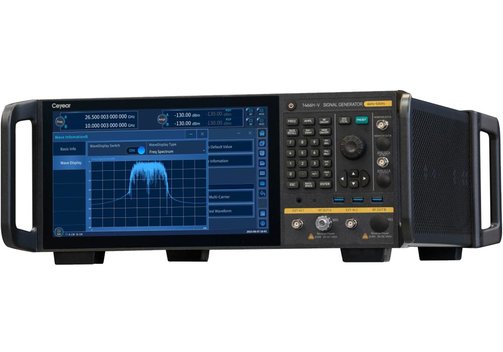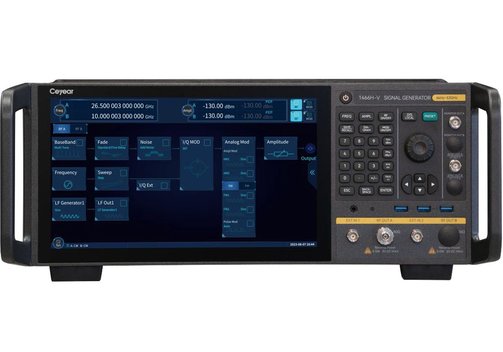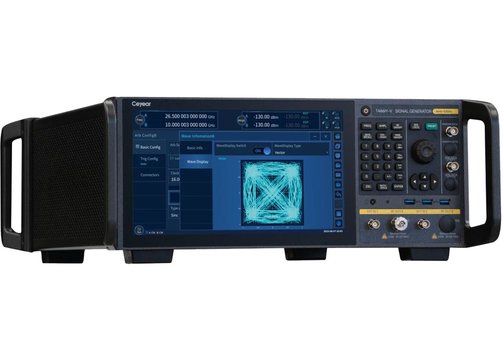Ceyear 1466/1466-V Analog and Vector Signal Generators up to 110GHz or 67GHz
Benefits of the Ceyear 1466(-V) Series Highend RF Signal Generators
- Analog signal generators from 6 kHz up to 110 GHz, vector signal generators from 6 kHz up to 67 GHz.
- Ideal for R&D, industrial testing, scientific research and teaching, in satellite and microwave communications, scientific research and teaching.
- Variety of flexible options according to aplication and budget.
Ceyear 1466/1466-V Analog and Vector Signal Generators up to 110 GHz or 67 GHz
The Ceyear 1466 series includes analog signal generators with frequency ranges from 6 kHz up to 110 GHz. Through integration with Ceyear 8240X analog signal source extender, the frequency range can be expanded to 750 GHz. The Ceyear 1466 series is an efficient tool for millimeter-wave 5G communication RF conformance testing.
The Ceyear 1466-V series includes vector signal generators with frequency ranges from 6 kHz up to 67 GHz and an excellent vector modulation accuracy. The series supports comprehensive standard digital modulation styles - generation of up to 30+ digital standard modulation signals (PSK, FSK, QAM, APSK).
- 1466 series analog signal generator from 6 kHz up to 13, 20, 33, 45, 53, 67, 90, or 110 GHz.
1466-V series vector signal generators from 6 kHz up to 13, 20, 33, 45, 54, or 67 GHz. - Excellent spectral purity, making cutting-edge testing easier.
SSB phase noise: -145 dBc/Hz at 10 kHz offset at 1 Hz carrier, -132 dBc/Hz at 10 kHz offset at 10 GHz carrier,
wideband noise: -161 dBc/Hz at 30 MHz offset at 20 GHz carrier,
spurious <-80 dBc at 10 GHz carrier,
harmonics <-55 dBc. - Full range of analog modulations.
- -V series:
Full range of analog modulation and comprehensive standard digital modulation styles.
Arbitrary wave playback.
Multicarrier signal generation.
Multiple types of noise addition methods.
Intra-pulse modulation.
Mobile communication signal simulation, WLAN signal simulation, and more. - Touch-screen operation.
- SCPI command real-time recording and operation project automatic builder: export recorded SCPI commands with one click, automatically generate VS (C++, C#), Qt, Matlab, LabVIEW program control example projects.
Model Overview 1466 Analog Series
| Model | 1466C | 1466D | 1466E | 1466G | 1466H | 1466L | 1466N | 1466P | |
| Type | Analog signal generatorwith top performance and functionality, especially in higher frequencies, higher signal spectral purity, higher output power, and dual-RF channels | ||||||||
| Frequency range | 6 kHz...13 GHz | 6 kHz...20 GHz | 6 kHz...33 GHz | 6 kHz...45 GHz | 6 kHz...53 GHz | 6 kHz...67 GHz | 6 kHz...90 GHz | 6 kHz...110 GHz | |
| Frequency range and N1 6 kHz≤ f ≤10 MHz: - 10 MHz< f ≤50 MHz: - 50 MHz< f ≤62.5 MHz: 1/256 62.5 MHz< f ≤125 MHz: 1/128 125 MHz< f ≤250 MHz: 1/64 250 MHz< f ≤500 MHz: 1/32 500 MHz< f ≤1 GHz: 1/16 1 GHz< f ≤2 GHz: 1/8 2 GHz< f ≤4 GHz: 1/4 4 GHz< f ≤8 GHz: 1/2 8 GHz< f ≤20 GHz: 1 20 GHz< f ≤40 GHz: 2 40 GHz< f ≤67 GHz: 4 100 GHz< f ≤110 GHz: 6 | |||||||||
| Resolution | 0.001 Hz | ||||||||
| Spectral purity | (details see datasheet) SSB phase noise: -145 dBc/Hz at 10 kHz offset at 1 GHz carrier, -132 dBc/Hz at 10 kHz offset at 10 GHz carrier, wideband noise: -161 dBc/Hz at 30MHz offset at 20 GHz carrier, spurious <-80 dBc at 10 GHz carrier, harmonics <-55 dBc | ||||||||
| Sweep | Sweep modes: step sweep, list sweep, ramp sweep (analog, option S15), power sweep (option S16) | ||||||||
| Modulation (options) | Frequency modulation, phase modulation, amplitude modulation, pulse modulation; 10 MHz LF/function generator out supports amplitude/frequency/phase modulation | ||||||||
| Display | 11.6"/29.5 cm graphical color touch-screen display | ||||||||
| Interfaces | Cross-platform browser based remote control; SCPI command real-time recording and operation project automatic builder | ||||||||
| Dimensions(mm) | 475 x 193 x 620 (incl. handle and protective bottom corner)/426 x 177 x 500 (excludes handle and protective bottom corner); depending on version/options <35 kg | ||||||||
Included: Signal generator 1466 C, D, E, G, H, L, N, or P, power cable, quick guide, certification of conformity.
Model Overview 1466-V Vector Series
| Model | 1466C-V | 1466D-V | 1466E-V | 1466G-V | 1466H-V | 1466L-V | |||
| Type | Vector signal generatorwith top performance and functionality, especially in higher frequencies, wider bandwidths, higher signal spectral purity, higher output power, better EVM and high-precision synchronized multichannel applications | ||||||||
| Frequency range | 6 kHz...13 GHz | 6 kHz...20 GHz | 6 kHz...33 GHz | 6 kHz...45 GHz | 6 kHz...53 GHz | 6 kHz...67 GHz | |||
| Frequency range and N1 (internal YO harmonic number) 6 kHz≤ f ≤10 MHz: - 10 MHz< f ≤50 MHz: - 50 MHz< f ≤62.5 MHz: 1/256 62.5 MHz< f ≤125 MHz: 1/128 125 MHz< f ≤250 MHz: 1/64 250 MHz< f ≤500 MHz: 1/32 500 MHz< f ≤1 GHz: 1/16 1 GHz< f ≤2 GHz: 1/8 2 GHz< f ≤4 GHz: 1/4 4 GHz< f ≤8 GHz: 1/2 8 GHz< f ≤20 GHz: 1 20 GHz< f ≤40 GHz: 2 40 GHz< f ≤67 GHz: 4 | |||||||||
| Resolution | 0,001 Hz | ||||||||
| Spectral purity | (details see datasheet) SSB phase noise: -145 dBc/Hz at 10 kHz offset at 1 GHz carrier, -132 dBc/Hz at 10 kHz offset at 10 GHz carrier, wideband noise floor: -161 dBc/Hz at 30 MHz offset at 20 GHz carrier, spurious <-80 dBc at 10 GHz carrier, harmonics <-55 dBc | ||||||||
| Sweep | Sweep modes: step sweep, list sweep, ramp sweep (analog, option S15), power sweep (option S16) | ||||||||
| Modulation (options) | Frequency modulation, phase modulation, amplitude modulation, pulse modulation; 10 MHz LF/function generator out supports amplitude/frequency/phase modulation | ||||||||
| Display | 11.6"/29.5 cm graphical color touch-screen display | ||||||||
| Interfaces | |||||||||
| Dimensions(mm) | 475 x 193 x 620 (incl. handle and protective bottom corner)/426 x 177 x 500 (excludes handle and protective bottom corner); depending on version/options <35 kg | ||||||||
Included: Signal generator 1466 C-V, D-V, E-V, G-V, H-V, or L-V, power cable, quick guide, certification of conformity.
Ceyear 1466(-V) Series Options and Accessories
| Model | Description |
| 1466-07 | 100 MHz/1 GHz reference input and output; support 100 MHz or 1 GHz reference signal input and output functions, for 1466 and 1466-V series |
| 1466-H01-130 | 130 dB programmable step attenuator, to expand output power dynamic range for 1466C/D/E/G(-V) |
| 1466-H01-120 | 120 dB programmable step attenuator, to expand output power dynamic range for 1466H/L(-V) |
| 1466-H01-90 | 90 dB programmable step attenuator, to expand output power dynamic range for 1466H/L(-V) |
| 1466-H01-50 | 50 dB programmable step attenuator, to expand output power dynamic range for 1466N/P |
| 1466-H01-B130 | Channel B 130 dB programmable step attenuator, to expand channel B output power dynamic range for 1466C/D(-V), requires option 1466-H11-B13/B20 |
| 1466-H04-1 | Low phase noise, improved phase noise performance, 10 GHz at 10 kHz: -120 dBc/Hz |
| 1466-H04-2 | Ultra low phase noise, improved phase noise performance, 10 GHz at 10 kHz: -128 dBc/Hz |
| 1466-H04-B1 | Channel B low phase noise, improved channel B phase noise performance, 10 GHz at 10 kHz: -120 dBc/Hz, regarding options 1466-H11-B13/B20 |
| 1466-H04-B2 | Channel B ultra low phase noise, improved channel B phase noise performance, 10 GHz at 10 kHz: -128 dBc/Hz, regarding options 1466-H11-B13/B20 |
| 1466-H05-13 | 13 GHz high output power: improve maximum output power for 1466C(-V) |
| 1466-H05-20 | 20 GHz high output power: improve maximum output power for 1466D(-V) |
| 1466-H05-33 | 33 GHz high output power: improve maximum output power for 1466E(-V) |
| 1466-H05-45 | 45 GHz high output power: improve maximum output power for 1466G(-V) |
| 1466-H05-53 | 53 GHz high output power: improve maximum output power for 1466H(-V) |
| 1466-H05-67 | 67 GHz high output power: improve maximum output power for 1466L(-V) |
| 1466-H05-90 | 90 GHz high output power: improve maximum output power for 1466N |
| 1466-H05-110 | 110 GHz high output power, improve maximum output power for 1466P |
| 1466-H05-B13 | 13 GHz channel B high output power, improve channel B max. output power for 1466C, option 1466-H11-B13 required |
| 1466-H05-B20 | 20 GHz channel B high output power, improve channel B max. output power for 1466D, option 1466-H11-B20 required |
| 1466-H11-B13 | Add Channel B, output 6 kHz...13 GHz analog signal for 1466C/D |
| 1466-H11-B20 | Add Channel B, output 6 kHz...20 GHz analog signal for 1466D |
| 1466-H11-BV13 | Add channel B, output 6 kHz...13 GHz vector signal for 1466D-V |
| 1466-H11-BV20 | Add channel B, Output 6 kHz...20 GHz vector signal for 1466D-V |
| 1466-H31-500 | Internal modulation bandwidth 500 MHz for 1466-V series |
| 1466-H31-1000 | Internal modulation bandwidth 1 GHz for 1466-V series |
| 1466-H31-2000 | Internal modulation bandwidth 2 GHz for 1466-V series |
| 1466-H31-B500 | Channel B internal modulation bandwidth 500 MHz for 1466-V series; option 1466-H11-BV13 or 1466-H11-BV20 required |
| 1466-H31-B1000 | Channel B internal modulation bandwidth 1 GHz for 1466-V series; option 1466-H11-BV13 or 1466-H11-BV20 required |
| 1466-H31-B2000 | Channel B internal modulation bandwidth 2 GHz for 1466-V series; option 1466-H11-BV13 or 1466-H11-BV20 required |
| 1466-H32 | Internal baseband large capacity memory: Expand internal baseband memory to 16 GB (for 1466-V series) |
| 1466-H32-B | Channel B internal baseband large capacity memory: Expand channel B internal baseband memory to 16 GB (for 1466-V series), option 1466-H11-BV13 or option 1466-H11-BV20 required |
| 1466-H33 | Add wideband external IQ input function (1466-V series) |
| 1466-H33-B | Add channel B wideband external IQ input (1466-V series), option 1466-H11-BV13 or option 1466-H11-BV20 required |
| 1466-H36 | Phase coherence extension: Realize phase coherent input-output (1466-V series) |
| 1466-H94 | Rack mount kit |
| 1466-H98 | English panel and English operation interface |
| 1466-H99 | High-intensity portable aluminum alloy transport case, with carrying handle and omni-directional wheel, convenient for transportation |
| 1466-H100 | User manual paper version |
| 1466-S01 | Arbitrary waveform modulation function, support arbitrary wave data download and playback, baseband signal generation or signal playback, for 1466-V series |
| 1466-S02 | Multitone modulation signal generation function, for 1466-V series |
| 1466-S03 | Intrapulse modulation Chirp, Barker Code, etc., for 1466-V series |
| 1466-S04 | AWGN generation, support pure noise generation, white Gaussian noise (AWGN) and continuous wave interference functions, for 1466-V series |
| 1466-S06 | Segment waveform file generation, realize the digital modulation signal generated waveform segment file, for 1466-V series |
| 1466-S07 | Sequencing file generation to achieve multiple waveform segment files generated sequence files, for 1466-V series; option S01 required |
| 1466-S08 | Multicarrier waveform generation signal generation, for 1466-V series; option S01 required |
| 1466-S09 | Frequency hopping signal generation, for 1466-V series |
| 1466-S11 | Add analog modulation function incl. AM, FM, ΦM for 1466 and 1466-V series |
| 1466-S12 | Add pulse modulation function, minimum pulse width 100 ns for 1466 and 1466-V series |
| 1466-S13 | Add narrow pulse modulation function, minimum pulse width 20 ns for 1466 and 1466-V series |
| 1466-S14 | Add LF/low frequency output and function waveform signal generation for 1466 and 1466-V series |
| 1466-S15 | Add analog sweep function (ramp sweep) for 1466 and 1466-V series |
| 1466-S16 | Add power sweep function for 1466 and 1466-V series |
| 1466-S21 | Wireless connection signal simulation function 802.11a/b/g/n/ac/ax (Wi-Fi1 - Wi-Fi6): Wireless connection PPDU, MPDU, A-MPDU and other signal simulation, with leading, data domain, MAC frame, PE, space mapping and other module parameter settings. It supports physical frame block signal simulation consisting of multiple PPDUs with different modulation and coding modes; for 1466-V series |
| 1466-S22 | Wireless connection signal simulation function 802.11be (WIFI7): Wireless connection signal simulation. Supports the corresponding protocol standards, PPDU format, MAC frame type, transmission mode, PPDU and other parameters. Support for multiple RU (MRUs) options and enhanced OFDMA emulation; for 1466-V series |
| 1466-S23 | Bluetooth signal simulation: support basic rate (BR) and enhanced rate (EDR) Bluetooth signal simulation, providing three transmission mode ACL+EDR, SCO, eSCO+EDR; supports Bluetooth Low Energy (LE) signal simulation, supports two channel types: Broadcast and Data; for 1466-V series |
| 1466-S31 | Communication signal simulation GSM/EDGE: support normal symbol rate full speed/half speed conventional, synchronous, frequency correction, access and null burst types, as well as high symbol rate burst types; support normal symbol rate MSK/FSK, AQPSK, 8PSK, 16QAM, 32QAM and high symbol rate QPSK, 16QAM, 32QAM modulation; support single frame, double frame and no frame 3 different types of frame structure configuration; support independent power configuration for each time slot; support channel coding for each time slot; support wide pulse and narrow pulse filtering with high symbol rate; supports up to 64 multi-carrier configurations; for 1466-V series |
| 1466-S33 | Communication signal simulation LTE/LTE-ADVANCED uplink: support FDD/TDD duplex mode, PRACH, PUCCH, PUSCH and other uplink channels and DMRS uplink signal simulation of different bandwidth and modulation coding modes, with A1 to A8 a total of 44 categories of FRC signal simulation functions; downlink: support FDD/TDD duplex mode, PBCH, PCFICH, PHICH, PDCCH, PDSCH and other downlink channels and CRS, PSS, SSS and other downlink signal simulation under Auto DCI/Manual scheduling PDSCH mode. It has the aggregation function of up to 5 carriers, the multi-antenna setting function of up to 4 antennas, and a total of 8 TestModel signal simulation functions of E-TM1~E-TM3; for 1466-V series |
| 1466-S34 | Communication signal simulation 5G NR: support 5G NR protocol R16 signal generation, including a variety of bandwidth and subcarrier interval settings; it can generate more than 600 testmodels and FRCS, support one-click simulation of standard protocol signals, and quickly establish test scenarios. Support uplink PUSCH, PUCCH, PRACH, downlink PDSCH CORESET multi-channel time-frequency resource detailed configuration, PDSCH/PUSCH channel coding, multi-antenna, multi-layer transmission simulation; support CSI-RS, SRS, SS/PBCH, PRS, LTE-CRS and other signal configurations; support a variety of upstream and downstream DCI formats in CORESET, DCI automatically calls PDSCH configuration; support carrier aggregation and cross-carrier scheduling; supports a variety of filters and user-defined filter configurations; for 1466-V series |
| 1466-S35 | Communication signal simulation NB-Iot Uplink: it supports Standalone, In_band, Guard_band and other deployment modes, and has uplink channel functions such as NPUSCH and NPRACH with different bandwidths and modulation and coding modes. The NPUSCH format includes F1 and F2. The signal styles include single-tone(15 kHz/3.75 kHz) and SC-FDMA(15 kHz). Downlink: support Standalone, In_band, Guard_band and other three deployment modes, with different bandwidth and modulation coding mode of NPBCH, NPDCCH, NPDSCH and other downlink signal simulation functions such as NPSS, NSSS, NRS, DCI format includes N0, N1, N2 three. NPDCCH search space includes UE specific, type1 common and type2 common; for 1466-V series |
| 1466-S61 | Digital broadcast signal simulation DVB-H/T/T2/S2/S 2X: support DVB-H, DVB-T, DVB-T2, DVB-S2X protocol; support for data channel coding according to protocol standards, including scrambling, interleaving, external code (BCH), and internal code (LDPC) with rate from 1/4 to 31/45; configurable baseband (BB) head, VL-SNR head, TS head, GSE head; support DVB-S2 modulation scheme: QPSK, 8APSK, 8PSK, 16APSK, 32APSK, 64APSK, 128APSK, 256APSK; support QPSK, p/2BPSK in VL-SNR mode; support pilot insertion and configuration; supports superframe configuration, hop beam configuration, and configurable dwell time; for 1466-V series |
| 1466x-JL | Calibration service, provide metrology/calibration services and provide metrological reports - on request |
Information on product safety:
Manufacturer:
Ceyear Technologies Co., Ltd, No.98, Xiang Jiang Road, Huangdao District, Qingdao/CHN
www.ceyear.com
Responsible person:
Meilhaus Electronic GmbH, Am Sonnenlicht 2, 82239 Alling/DEU
info@meilhaus.com



































